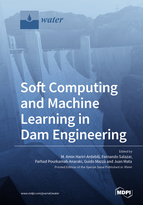Soft Computing and Machine Learning in Dam Engineering
A special issue of Water (ISSN 2073-4441). This special issue belongs to the section "New Sensors, New Technologies and Machine Learning in Water Sciences".
Deadline for manuscript submissions: closed (21 October 2022) | Viewed by 34641
Special Issue Editors
2. College of Computer, Mathematical and Natural Sciences, University of Maryland, College Park, MD 20742, USA
Interests: advanced analysis of infrastructures; earthquake engineering; scientific machine learning; coupled systems mechanics; uncertainty quantification and resilience
Special Issues, Collections and Topics in MDPI journals
Interests: machine learning in civil engineering problems; dam safety; dam hydraulics; structural health monitoring; uncertainty quantification
Special Issues, Collections and Topics in MDPI journals
Interests: machine learning for scientific computing; uncertainty quantification; large-scale data analysis; computational mathematics; mathematical optimization
Interests: safety and risk assessment of dams and appurtenant structures
Special Issues, Collections and Topics in MDPI journals
Interests: dam engineering; dam surveillance; structural health monitoring; machine learning; management information systems; decision making
Special Issues, Collections and Topics in MDPI journals
Special Issue Information
Dear Colleagues,
Dams are critical infrastructures, and their operation is governed by many engineering, social, economic, and (and sometimes) political factors. The role of dam engineers has dramatically changed over the last three decades (mainly from the design of new dams to safety analysis of the existing ones). Thanks to new technologies, a considerable amount of data is collected from field monitoring or can be generated from computer simulations. Now the question is, “how can we effectively utilize all the available data?” A promising solution relies on integrating “Dam Engineering” and “Computer Science”. There are several innovative solutions at a high level of maturity that have great potential for application in dam engineering, including machine learning and soft computing.
In this Special Issue, we solicit high-quality original research articles focused on state-of-the-art techniques and methods employed in the design and analysis of dams. We welcome both theoretical and application papers of high technical standards across various disciplines, thus facilitating an awareness of techniques and methods in one area that may apply to other areas. We seek high-quality submissions of original research articles as well as review articles on all aspects related to artificial intelligence in dam engineering and appurtenant structures that have the potential for practical application.
Topics of interest include but are not limited to:
- Soft computing and machine learning for dam response prediction;
- Application of machine learning on dam monitoring data;
- Big data analytics from numerical simulations;
- Data processing from structural, material, and hydrologic aspects;
- Advanced design techniques with optimized geometry;
- Case studies with open-source data to be used in machine learning;
- Advanced mathematical models and machine learning techniques;
- Dam safety, risk-informed decision making, and failure mode analysis;
- Multihazard (e.g., earthquake, flood, aging) prediction models;
- Validations and verifications of response prediction models;
- Advances in sustainable and resilient dams, as well as socioeconomic aspects;
- Investigating the robustness of machine learning methods.
Dr. M. Amin Hariri-Ardebili
Prof. Fernando Salazar
Prof. Farhad Pourkamali-Anaraki
Eng. Guido Mazza
Dr. Juan Mata
Guest Editors
Manuscript Submission Information
Manuscripts should be submitted online at www.mdpi.com by registering and logging in to this website. Once you are registered, click here to go to the submission form. Manuscripts can be submitted until the deadline. All submissions that pass pre-check are peer-reviewed. Accepted papers will be published continuously in the journal (as soon as accepted) and will be listed together on the special issue website. Research articles, review articles as well as short communications are invited. For planned papers, a title and short abstract (about 100 words) can be sent to the Editorial Office for announcement on this website.
Submitted manuscripts should not have been published previously, nor be under consideration for publication elsewhere (except conference proceedings papers). All manuscripts are thoroughly refereed through a single-blind peer-review process. A guide for authors and other relevant information for submission of manuscripts is available on the Instructions for Authors page. Water is an international peer-reviewed open access semimonthly journal published by MDPI.
Please visit the Instructions for Authors page before submitting a manuscript. The Article Processing Charge (APC) for publication in this open access journal is 2600 CHF (Swiss Francs). Submitted papers should be well formatted and use good English. Authors may use MDPI's English editing service prior to publication or during author revisions.
Keywords
- dams
- machine learning
- soft computing
- natural hazard
- monitoring data
- numerical simulations
- safety
- risk
- resilience
- validation
- uncertainty quantification










